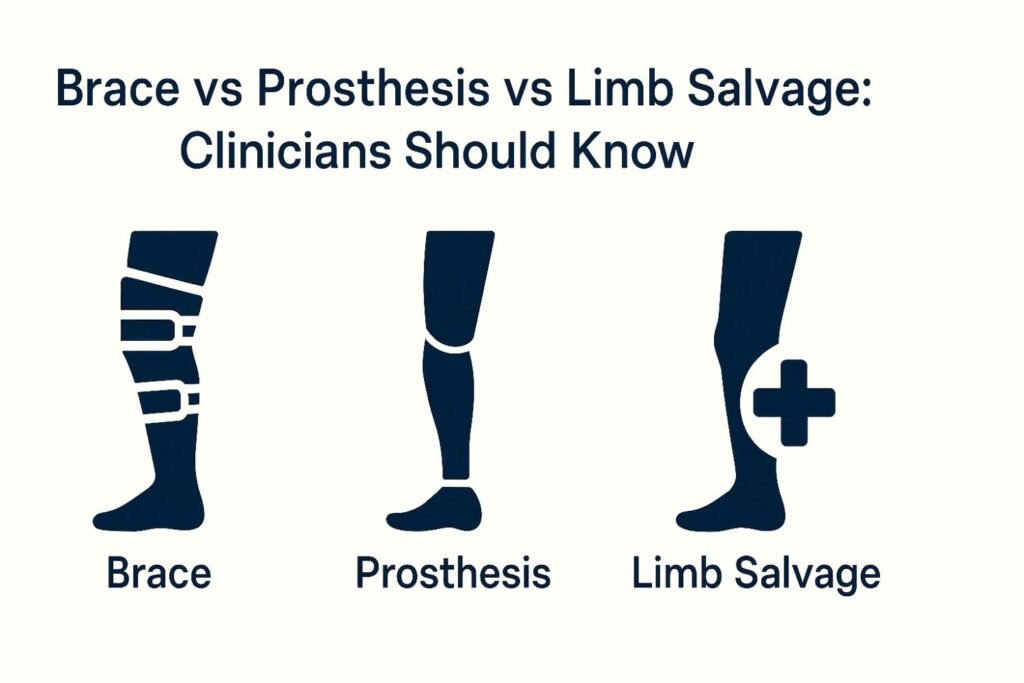When a limb is badly injured or weakened by disease, doctors often face a difficult choice: brace the limb, salvage it through surgery, or move toward amputation and prosthetic fitting.
Each path can help a patient regain movement, but each comes with its own benefits, risks, timeframes, and long-term outcomes.
For clinicians, understanding these differences clearly is essential for guiding patients with confidence and compassion.
Comparing braces, prosthetic care, and limb-salvage surgery helps doctors set the right expectations, reduce complications, and support the patient’s physical and emotional well-being over months and years—not just during the early recovery phase.
Understanding the Three Pathways
How Bracing Supports the Natural Limb
Bracing is often the first approach when the limb still has structural potential.
A brace supports weak joints, stabilizes fragile bones, and allows controlled movement without major surgery.
It preserves the natural limb, which can feel emotionally reassuring for many patients.
However, bracing also depends heavily on patient strength, joint health, and long-term tolerance of the device.
Some patients thrive with a brace, while others experience discomfort, slow progress, or limited mobility.
How Limb Salvage Tries to Restore Function Through Surgery
Limb salvage aims to save the limb through reconstruction, implants, grafts, or bone-lengthening procedures.
It can preserve sensation and natural anatomy, giving patients the chance to return to familiar movement patterns.
But these surgeries are often long, complex, and require multiple stages of healing.
The recovery is slow, and complications such as infection, nonunion, and chronic pain are common.
Even when successful, limb salvage may not restore full function.
How Prosthetic Care Offers a New Start Through Amputation
Prosthetic rehabilitation becomes the path when the limb cannot be saved or would cause lifelong pain.
A well-fitted prosthesis restores mobility quickly, with predictable training and shorter recovery timelines.
Modern prosthetic technology offers strong stability, high performance, and high quality of life.
For many patients, amputation and prosthesis bring the fastest return to function—but it requires emotional readiness and steady clinical support.
When Bracing Works Best
When the Limb Has Enough Structural Strength
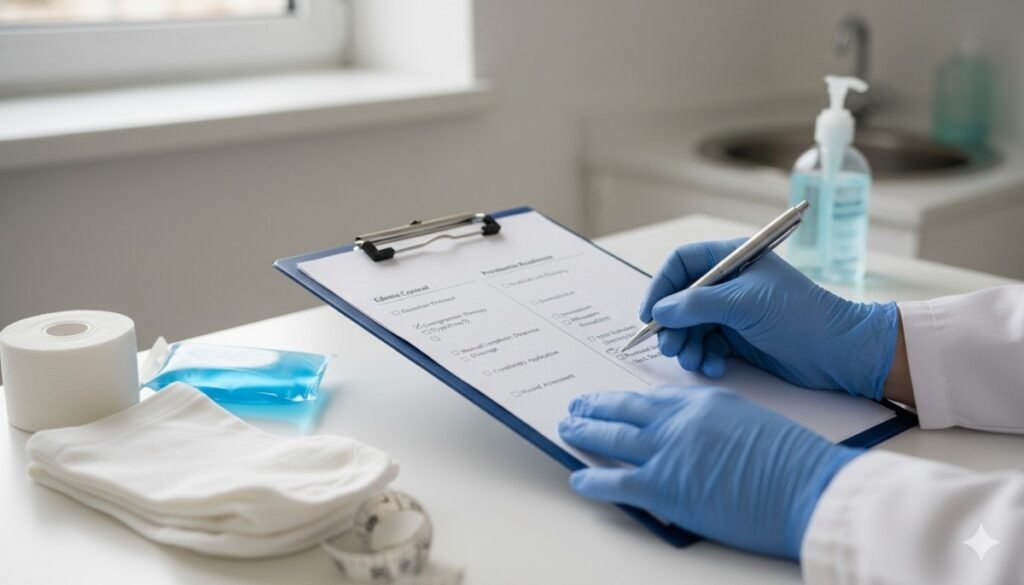
Bracing is most effective when bones, joints, and soft tissues can still carry part of the body’s weight.
The brace acts as reinforcement, not replacement.
If structural damage is too severe, a brace may feel heavy, unstable, or painful.
Clinicians must assess whether the limb can truly handle long-term bracing.
When Stability Is More Important Than Speed
Some patients do not need high performance—they need predictable stability in daily life.
A brace can offer this stability, especially for mild-to-moderate deformities.
Patients who walk short distances often benefit from this approach.
Those who require high activity may find bracing limiting.
When Avoiding Major Surgery Is the Priority
Bracing becomes the preferred option when surgery is too risky or the patient’s health is fragile.
It avoids long hospital stays and protects patients who cannot tolerate anesthesia or multi-stage operations.
For this group, bracing becomes a safe, conservative path that supports mobility gently.
Limitations of Bracing
Why Long-Term Comfort Can Decline
Braces can cause rubbing, sweating, stiffness, and pressure points.
Over time, discomfort may reduce daily wear and limit activity.
If the brace is not worn consistently, mobility deteriorates.
Clinicians must monitor comfort closely to prevent abandonment.
Why Muscles May Weaken Over Time
Some braces restrict movement to prevent injury.
But restricted movement also reduces muscle activity.
Weakening muscles can worsen gait and increase fall risk.
Patients need strengthening exercises to maintain balance and joint health.
Why Bracing May Delay Needed Intervention
Trying a brace for too long sometimes delays a better solution.
If progress is slow or pain increases, clinicians must reassess early.
A shift toward limb salvage or prosthetic care may offer better long-term outcomes.
Timely decision-making protects patients from prolonged difficulty.
When Limb Salvage Is the Right Path
When Tissue Quality Allows Reconstruction
Limb salvage is ideal when blood supply, soft tissue, and bone health are strong enough to support healing.
These factors determine whether grafts, implants, or reconstructive techniques can succeed.
Doctors must evaluate these tissues carefully before recommending salvage.
When Preserving Sensation Is Critical
Natural sensation is valuable for balance and coordination.
If the limb still has healthy nerve pathways, limb salvage may preserve important sensory feedback.
This can improve stability and reduce fall risk in the long run.
When Patients Strongly Prefer to Keep Their Limb
Emotional attachment to a limb is powerful.
Some patients feel deeply motivated to save it, even if recovery is long.
With the right medical foundation, limb salvage supports this emotional need.
Shared decision-making helps align treatment with patient values.
Challenges and Risks of Limb Salvage
Why Healing Takes Long Timeframes
Limb salvage often requires multiple surgeries and long rehabilitation.
Bone grafts, implants, and fixation methods need months to integrate.
During this time, movement is limited and progress is slow.
Clinicians must set realistic expectations to prevent frustration.
Why Infection Risk Is High
Surgical reconstruction involves large wounds and implants.
Patients may face recurrent infections, which can delay healing or threaten the entire limb.
Monitoring wound health becomes critical to prevent complications.
Why Chronic Pain Is Common
Even when the limb is saved, pain from scarring, nerve irritation, and joint stiffness may remain.
Some patients regain mobility but live with ongoing discomfort.
Doctors must balance functional success with long-term quality of life.
When Prosthetic Rehabilitation Becomes the Better Option
When Limb Salvage Will Not Restore Functional Movement
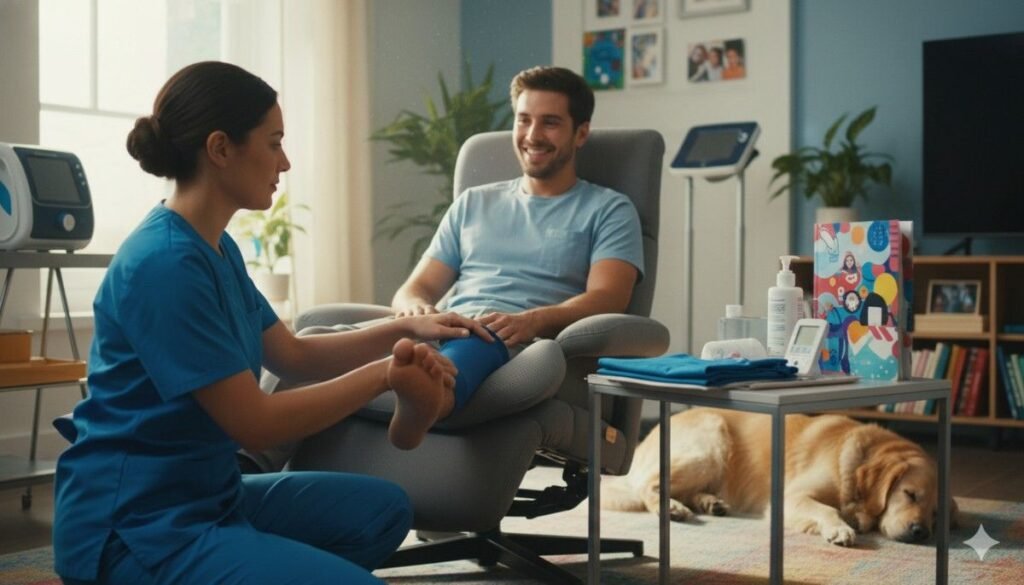
If reconstruction cannot create a stable, pain-free limb, amputation may be the safer path.
A prosthesis offers predictable stability and the ability to walk with confidence.
Choosing this path early prevents years of struggle.
When Pain Overrides Potential Function
For some patients, the pain of a salvaged limb becomes overwhelming.
They may walk slowly, rely on aids, or avoid movement altogether.
A prosthesis can restore independence by removing the source of chronic pain.
When Delayed Mobility Affects Mental Health
Long periods of immobility impact mood, confidence, and emotional resilience.
A prosthesis offers quicker return to activity and a more structured rehab timeline.
This helps patients regain purpose and social participation sooner.
Benefits of Prosthetic Outcomes
Faster Return to Daily Activities
Prosthetic rehabilitation has predictable timelines.
Most patients walk within weeks and reach meaningful independence within months.
This speed shortens downtime and supports emotional recovery.
Doctors appreciate the stability and visibility of progress.
Greater Control Over Pain
Removing the damaged limb eliminates many sources of chronic pain.
Prosthetic users often report far lower pain levels than limb-salvage patients.
Residual-limb care focuses on comfort and pressure management.
This clarity helps clinicians manage pain more effectively.
High Mobility Potential With Modern Technology
Advances in socket design, suspension systems, and prosthetic feet allow smooth, stable walking.
Some patients return to outdoor walking, sports, or physically demanding work.
Prostheses open doors that bracing and salvage cannot always provide.
Key Considerations When Comparing All Three Paths
Evaluating Patient Health
Fragile health makes long surgery risky and limits bracing tolerance.
Prosthetic care may be the safest path for medically complex patients.
Doctors weigh comorbidities carefully before deciding.
Evaluating Patient Goals
Some patients want independence and speed.
Others simply want comfort and safety.
Matching treatment to their goals creates better satisfaction.
Honest conversations help guide direction.
Evaluating Long-Term Outcomes, Not Just Immediate Needs
Short-term solutions may feel easier, but long-term outcomes determine quality of life.
Doctors must look beyond today’s limitations to foresee future mobility.
Choosing early wisely prevents later regret.
How Each Path Shapes Daily Life
How Bracing Influences Everyday Movement
When a patient uses a brace, daily life often unfolds with a mix of confidence and caution.
A brace can give enough support to keep the limb steady during slow walking or short tasks, like moving around the kitchen or standing in a queue.
But the patient may feel the brace with every step — a sense of bulk, stiffness, or pressure that reminds them to move carefully.
In crowded places or uneven areas, they may slow down even more, because the brace cannot adapt to sudden shifts in ground or fast changes in direction.
The patient learns to “plan” their movements: stepping, turning, sitting, and rising with more intention than before.
How Limb Salvage Affects Daily Activity
Limb salvage often brings a complicated mix of hope and limitation.
On some days, the limb feels strong enough to support simple routines like getting dressed, making tea, or walking inside the home.
On other days, swelling, joint stiffness, or lingering surgical pain slows the patient down.
Because salvaged limbs often have reduced strength or flexibility, daily tasks require extra effort.
This creates a rhythm where patients must constantly listen to their bodies and adjust their activity levels.
For many, each day feels slightly different from the one before.
How Prosthetic Use Shapes Everyday Independence
A prosthesis often changes daily life in a more predictable way.
Once the socket fits comfortably and the patient learns safe walking patterns, movements begin to feel smoother and more natural.
Patients experience a sense of lightness — the freedom to move without guarding every step.
Climbing small slopes, walking on even ground, or navigating grocery aisles becomes part of a normal day again.
Many enjoy the relief of putting on the prosthesis in the morning and knowing exactly what to expect from it throughout the day.
This consistency builds trust, which is essential for long-term independence.
Emotional Realities Behind Each Option
The Emotional Weight of Bracing

Bracing can bring reassurance because it preserves the natural limb.
But it can also bring frustration when the brace feels heavy, hot, or difficult to manage.
Some patients grow tired of strapping, tightening, adjusting, and compensating for the brace throughout the day.
Emotionally, they may feel “limited but safe.”
It is a familiar limb, but not a fully reliable one.
Clinicians must help patients navigate these mixed feelings with patience.
The Emotional Rollercoaster of Limb Salvage
Limb salvage carries emotional highs and lows unlike any other option.
The hope of keeping the limb brings relief and motivation, but the long healing period can feel exhausting.
Multiple surgeries, slow progress, and persistent pain can drain emotional strength.
Some patients push forward with determination, while others feel discouraged by the constant unpredictability.
Emotional support becomes as important as physical care.
Doctors must help patients understand that their feelings are valid and part of a complex journey.
The Emotional Transition Into Prosthetic Use
Amputation can feel frightening at first — a moment of loss, a change in identity, a step into the unknown.
But as patients begin using their prosthesis, many feel a surprising sense of renewal.
They move faster, feel lighter, and regain control over their routines.
The prosthesis becomes a symbol of possibility rather than limitation.
Confidence grows as they realize they can walk, stand, cook, shop, and socialize again.
This emotional transformation is one of the most powerful advantages of prosthetic rehabilitation.
Clinical Metrics for Comparing Outcomes
How Clinicians Measure Success in Bracing
When using braces, clinicians look at stability, pain levels, daily walking distances, and how often the brace is actually worn.
If the patient avoids using the brace because it feels uncomfortable, the long-term outlook weakens.
A brace is only effective when it becomes part of the patient’s daily life.
Doctors also track muscle strength to ensure the brace is not causing even more weakness.
Consistency, comfort, and safe mobility form the core metrics.
How Limb Salvage Outcomes Are Evaluated
Outcomes for limb salvage include bone healing, joint range of motion, nerve recovery, and pain frequency.
Clinicians also track infection risk and swelling patterns, because these can derail progress quickly.
Even when the bone heals well, function may lag behind because soft tissues take much longer to regain strength.
Ultimately, success is measured by whether the limb allows safe walking and predictable daily activity — not just by how well the surgery went.
How Prosthetic Outcomes Are Measured
In prosthetic rehabilitation, metrics often show progress earlier: walking speed, step length, balance, endurance, and overall comfort.
Doctors also track socket fit, limb volume, and skin condition to prevent complications.
Patient-reported quality of life becomes an important measure because prosthetic independence strongly affects emotional well-being.
Consistent mobility is a key indicator that the prosthesis is supporting the patient’s goals.
Long-Term Implications Clinicians Must Consider
Considering Future Mobility
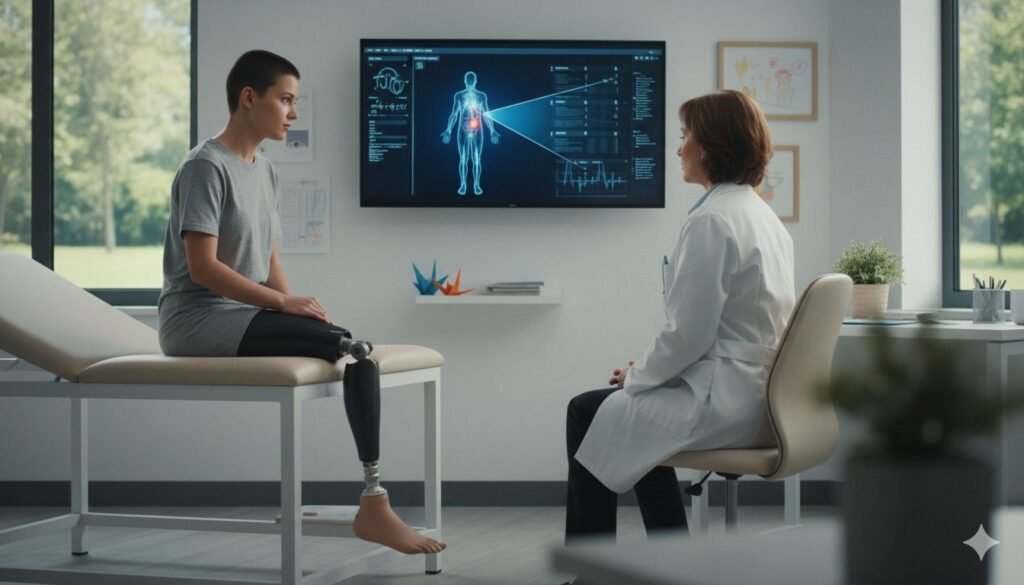
A brace may support the limb today but may not guarantee long-term mobility if the limb deteriorates.
Limb salvage might succeed structurally but still leave the patient with lifelong discomfort.
Prosthetic care often offers the clearest mobility path over many years, especially for active individuals.
Doctors must weigh future independence as carefully as current pain levels.
Considering Future Pain Levels
Persistent pain after limb salvage or chronic discomfort in a braced limb can limit activity and emotional health.
A prosthesis often removes the source of pain entirely, offering a clean start.
Clinicians must ask:
Is reducing today’s pain more important, or is preventing years of future pain the priority?
Considering Future Emotional Well-Being
Patients who feel trapped by slow recovery or lingering pain often experience frustration or withdrawal.
Those who walk confidently with a prosthesis often feel a renewed sense of identity and purpose.
Emotional health shapes the entire recovery journey.
A path that looks “easier” medically may not always offer the best emotional outcome.
Guiding Patients Toward the Right Decision
Helping Patients Understand Their Options With Clarity
When patients face the choice between bracing, limb salvage, and amputation with prosthetic rehabilitation, they often feel overwhelmed.
Each option carries its own hopes, fears, and uncertainties.
Doctors play a crucial role in simplifying these paths, explaining what each one means for daily life, long-term comfort, and future independence.
Patients need honest, clear guidance that respects both the medical facts and their emotional needs.
Clinicians help them understand not only what is possible, but what is sustainable.
Creating a Shared Decision-Making Process
The best outcomes happen when the patient feels included—not instructed.
Doctors walk patients through expected healing timelines, likely mobility levels, potential complications, and lifestyle implications.
This invites patients to speak openly about their goals, values, and personal priorities.
Some may value preserving their natural limb at all costs.
Others may prioritize walking quickly, returning to work, or reducing chronic pain.
Shared decision-making helps align treatment with the life the patient wants to rebuild.
Preparing Families for What Lies Ahead
Families often become the emotional anchor for the patient.
They help with rehabilitation, encourage progress, and provide support during difficult days.
Doctors must help families understand what to expect, how recovery will feel, and how they can support safe mobility at home.
When families are informed and confident, the patient feels more secure and motivated.
This shared understanding strengthens the entire recovery process.
Building Hope Through Honest Expectations
Patients recovering from limb loss or limb-saving interventions need hope—but they also need honesty.
They should know that bracing may limit long-term function, that limb salvage comes with long recovery and possible pain, and that prosthetic use requires practice and patience.
But they should also know that thousands of people walk again, work again, and regain independence through the right path.
Balance between realism and optimism gives patients courage without creating pressure.
Recognizing When It’s Time to Pivot
Sometimes a chosen path stops serving the patient.
A salvaged limb may develop chronic pain or recurrent infection.
A brace may no longer support the limb safely.
A patient may feel emotionally drained by slow recovery.
Clinicians must recognize when it is time to gently shift the treatment plan.
A pivot toward prosthetic care can be life-changing—restoring movement, resolving pain, and opening new possibilities.
The key is not to view change as failure, but as an opportunity for better long-term health.
Helping Patients Step Into the Future With Confidence
No matter which path the patient chooses, they need a clear roadmap.
Doctors outline short-term goals, long-term outcomes, signs of progress, and early warning signs of complications.
This creates a sense of direction that helps patients feel grounded and prepared.
Whether the journey continues with a brace, a salvaged limb, or a prosthesis, what matters most is that the patient feels supported at every step.
With careful guidance, steady follow-up, and compassionate communication, clinicians help patients move forward with dignity, strength, and renewed trust in their own bodies.
Robobionics Content said:
Conclusion: Choosing the Path That Truly Supports the Patient’s Life
Why the “Best” Option Is Different for Every Patient
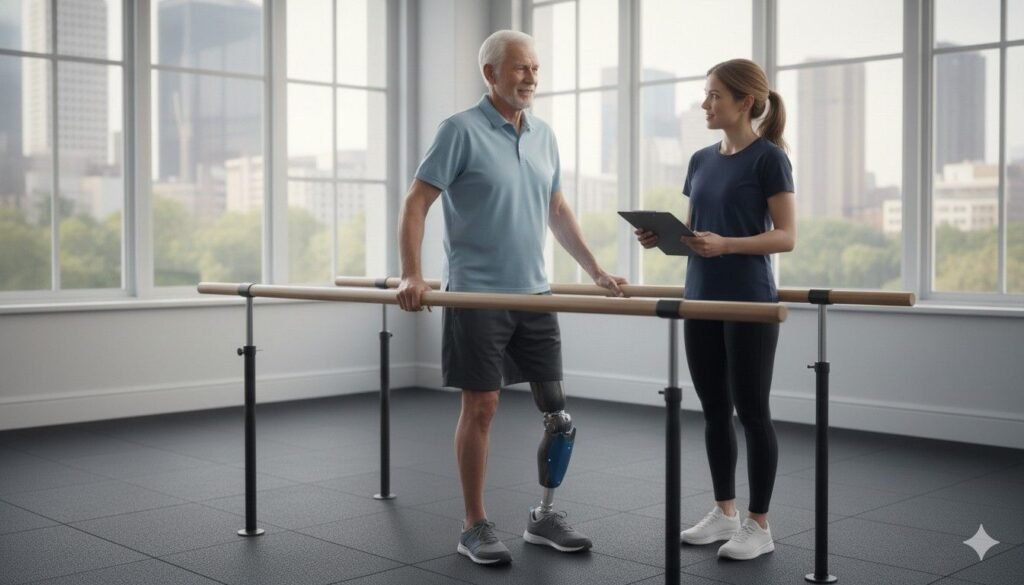
Bracing, limb salvage, and prosthetic rehabilitation are three very different journeys—each with its own pace, challenges, and potential.
No single approach is perfect for everyone, and no decision is simple.
Some patients do well with external support, some recover meaningfully through reconstruction, and others rediscover freedom through prosthetic use.
The key is understanding who the patient is, what they value, and what their body can realistically support.
How Clinicians Bring Clarity to a Complex Decision
Patients often look to their doctors not just for medical facts, but for interpretation, reassurance, and wisdom.
Clinicians help translate the science into human terms—explaining what each path feels like, how long recovery might take, and what everyday life may look like months and years ahead.
This clarity reduces fear, strengthens trust, and helps the patient feel empowered to choose confidently.
Why Long-Term Outcomes Matter More Than Short-Term Relief
A brace may feel easier at first, but may not provide lasting stability.
Limb salvage may preserve the limb, but may not restore comfortable, predictable function.
Prosthetic rehabilitation may feel overwhelming early on, but often leads to higher long-term mobility and quality of life.
Clinicians guide patients to think beyond the next few weeks—to imagine themselves six months, one year, or three years into the future.
The Role of Honest, Kind Conversations
Behind every decision is a human being trying to protect their dignity, identity, and independence.
These decisions require gentle communication—conversations where patients feel safe expressing fear, hope, confusion, or grief.
When clinicians listen without judgment, patients feel ready to move forward rather than freeze in uncertainty.
Honest dialogue builds a partnership that carries the patient through every stage of recovery.
Reassurance That Every Path Has Support
Whether the patient chooses bracing, attempts limb salvage, or transitions to a prosthesis, the journey does not end with the decision.
What matters is the ongoing support—careful monitoring, compassionate guidance, thoughtful adjustments, and steady encouragement.
Patients thrive when they know their clinicians are walking beside them, ready to guide, correct, support, and celebrate progress.
Helping Patients See the Strength in Their Choice
Every path requires courage.
Choosing to salvage a limb requires patience.
Choosing to brace a limb requires discipline.
Choosing a prosthesis requires emotional acceptance and willingness to start again.
Doctors can help patients see that none of these choices reflect weakness.
All of them reflect commitment to life, movement, and possibility.
Looking Forward With Purpose
With the right care plan, patients can regain independence, reduce pain, and build confidence in their daily routines.
They can return to work, rejoin social activities, walk in their neighbourhoods, and rebuild a life they feel proud of.
The path may differ, but the destination is shared: safe mobility, emotional well-being, and renewed quality of life.
For clinicians, guiding that journey is an honour.
For patients, choosing the right path becomes a powerful first step toward healing—not just physically, but emotionally and spiritually too.



